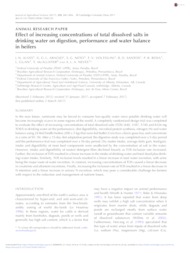Effect of increasing concentrations of total dissolved salts in drinking water on digestion, performance and water balance in heifers.
Effect of increasing concentrations of total dissolved salts in drinking water on digestion, performance and water balance in heifers.
Autoria: ALVES, J. N.; ARAUJO, G. G. L. de; G. NETO, S.; VOLTOLINI, T. V.; SANTOS, R. D. dos; ROSA, P. R.; GUAN, L.; McALLISTER, T.; NEVES, A. L. A.
Resumo: In the near future, ruminants may be forced to consume low-quality water since potable drinking water will become increasingly scarce in some regions of the world. A completely randomized design trial was completed to evaluate the effect of increasing concentrations of total dissolved salts (TDS) (640, 3187, 5740 and 8326 mg TDS/l) in drinking water on the performance, diet digestibility, microbial protein synthesis, nitrogen (N) and water balance using 24 Red Sindhi heifers (200 ± 5 kg) that were fed Buffel (Cenchrus ciliaris) grass hay and concentrate in a ratio of 50 : 50. After a 15-day diet adaptation period, the digestion study was completed over a 5-day period and the performance trial was completed over a 56-day period. Dry matter intake, average daily gain, feed:gain, intake and digestibility of most feed components were unaffected by the concentration of salt in the water. However, intake and digestibility of neutral detergent fibre declined linearly as TDS inclusion rate increased. Further, the inclusion of TDS resulted in a linear increase in the intake of drinking water and total (food plus drinking) water intake. Similarly, TDS inclusion levels resulted in a linear increase in total water excretion, with urine being the major route of water excretion. In contrast, increasing concentrations of TDS caused a linear decrease in creatinine and allantoin excretions. Finally, increasing the inclusion rate of TDS resulted in a linear decrease in N retention and a linear increase in urinary N excretion, which may pose a considerable challenge for farmers with respect to the reduction and management of nutrient losses.
Ano de publicação: 2017
Tipo de publicação: Artigo de periódico
Unidade: Embrapa Semiárido
Palavras-chave: Alimentação animal, Consumo, Consumo de água, Dieta, Digestion and performance, Nutrição animal, Água
Observações
1 - Por padrão são exibidas publicações dos últimos 20 anos. Para encontrar publicações mais antigas, configure o filtro ano de publicação, colocando o ano a partir do qual você deseja encontrar publicações. O filtro está na coluna da esquerda na busca acima.
2 - Para ler algumas publicações da Embrapa (apenas as que estão em formato ePub), é necessário ter, no celular ou computador, um desses softwares gratuitos. Sistemas Android: Google Play Livros; IOS: iBooks; Windows e Linux: software Calibre.
Acesse outras publicações
Acesse a Base de Dados da Pesquisa Agropecuária (BDPA) para consultar o acervo completo das bibliotecas da Embrapa.

